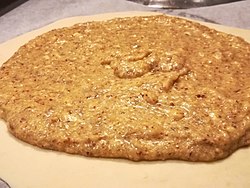
Back Frangipane Catalan Frangipane-Creme German Franĉipana kremo Esperanto Frangipane Spanish Frantxipan Basque Frangipane French פרנז'יפאן HE Ֆրանժիպան Armenian Crema frangipane Italian フランジパーヌ Japanese
 Frangipane cream before baking | |
| Type | Custard |
|---|---|
| Place of origin | France |
| Main ingredients | Almonds or almond flavouring, butter, sugar, eggs |

Frangipane (/ˈfrændʒɪpæn, -peɪn/ FRAN-jih-pa(y)n) is a sweet almond-flavored custard, typical in French pastry, used in a variety of ways, including cakes and such pastries as the Bakewell tart, conversation tart, Jésuite and pithivier.[1] A French spelling from a 1674 cookbook is franchipane, with the earliest modern spelling coming from a 1732 confectioners' dictionary.[2] Originally designated as a custard tart flavored by almonds or pistachios, it came later to designate a filling that could be used in a variety of confections and baked goods.
It is traditionally made by combining two parts of almond cream (crème d’amande) with one part pastry cream (crème pâtissière). Almond cream is made from butter, sugar, eggs, almond meal, bread flour, and rum; and pastry cream is made from whole milk, vanilla bean, cornstarch, sugar, egg yolks or whole eggs, and butter. There are many variations on both of these creams as well as on the proportion of almond cream to pastry cream in frangipane.[3][4]
On Epiphany, the French cut the king cake – a round cake made of frangipane layers – into slices to be distributed by a child known as le petit roi (the little king), who is usually hiding under the dining table. The cake is decorated with stars, a crown, flowers and a special bean hidden inside the cake. Whoever gets the piece of the frangipane cake with the bean is crowned "king" or "queen" for the following year.
- ^ Ayto, John (2013). The Diner's Dictionary. Oxford University Press.
- ^ Davidson, Alan (2014). "frangipane". In Jaine, Tom (ed.). The Oxford Companion to Food (3rd ed.). Oxford: Oxford University Press. doi:10.1093/acref/9780199677337.001.0001. ISBN 978-0-19-967733-7.
- ^ Suas, Michel (2011). Advanced Bread and Pastry: A Professional Approach. Delmar, Cengage Learning.
- ^ Jørgensen, Johannes (1913). Saint Francis of Assisi : a biography. University of Connecticut Libraries. New York: Longmans, Green, and Co. p. 257.
"Illam autem comestionem vocant Romani mortariolum quae fit de amygdalis et zucario et de aliis rebus." Spec. (ed. Sab.) p. 221. Sabatier identifies this favourite food of Francis with the well-known stone-hard Roman mostaccioli (see Jorgensen's "Pilgrimsbogen," p. 61). On the other side f. Edouard d'Alencon: Frere Jacqueline, p. 19, n. 2; in mortariolum (in Old French mortairol) he sees rather "cette creme d'amandes bien connue aujourd'hui sous le nom de frangipane," a name in which he finds an allusion to Jacopa's name (her married name was Frangipani).